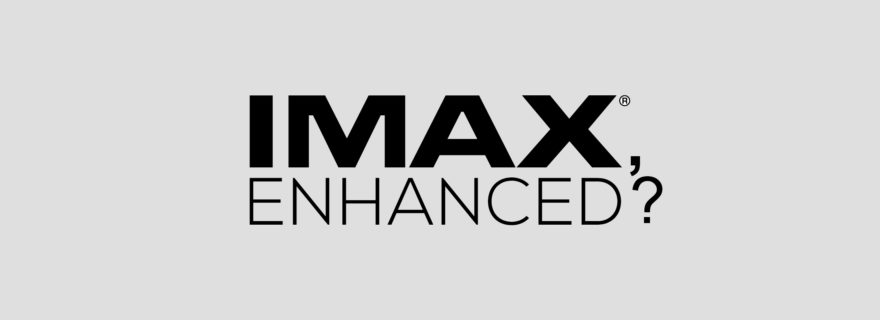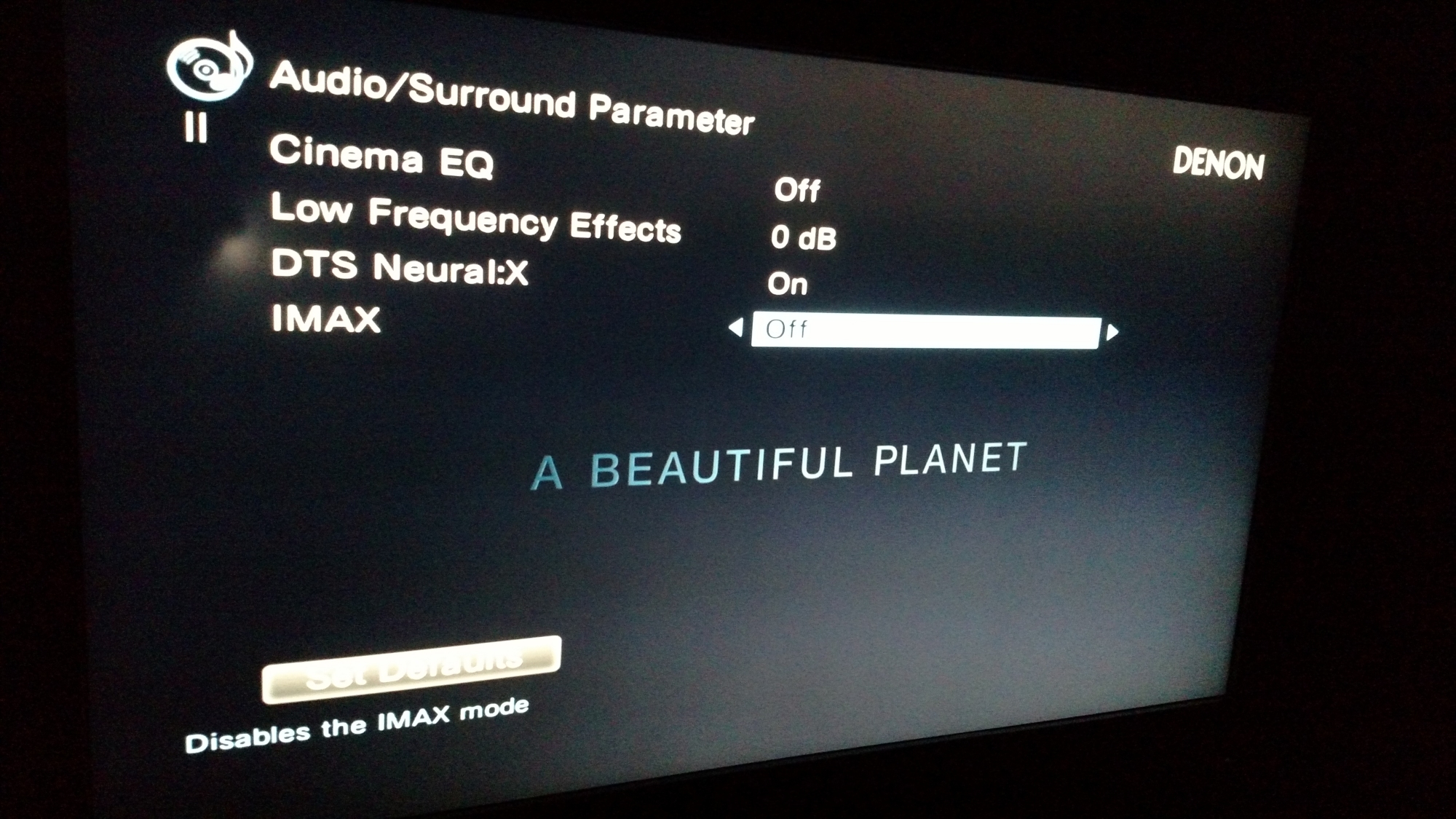Last week I shared my first impressions of the new IMAX Enhanced audio format, available on select A/V receivers and two movie discs to date. Additional testing has answered some of the questions I had, but I’m not sure I like those answers.
Both IMAX and DTS have been stingy with details about exactly what the IMAX Enhanced codec, which is built off the DTS:X format, does or how it differs from DTS:X. After my first round of listening, it didn’t seem to do anything that DTS:X (or Dolby Atmos) doesn’t already do, beyond displaying the word “IMAX” on the receiver’s front panel. By digging around in my receiver’s menu system, I discovered an option in the Surround Parameter menu with the ability to turn the IMAX mode on or off. Turning it off will play the disc’s soundtrack as DTS:X with no IMAX indicator.
Flipping the setting back and forth allowed me to compare the same movie soundtrack (the majority of my testing was done with the A Beautiful Planet disc) played as both DTS:X or IMAX Enhanced DTS:X. Doing so revealed that, in fact, the IMAX mode does sound and measure different than the normal DTS:X mode. Is different better? That’s a harder question to answer.
All About That Bass
The first thing to understand is that IMAX treats bass differently than normal movie soundtracks. A traditional 5.1 or higher sound mix will use the .1 channel for Low Frequency Effects while retaining a healthy amount of bass in the other channels. During home theater playback, your speaker crossover settings will move some of that bass from the main channels and mix it into the .1 channel so that your subwoofer can reproduce it. An IMAX theatrical mix, on the other hand, doesn’t have an LFE channel. Depending on the theater installation, the soundtrack will either be 5.0, 6.0, or 12.0 with bass high-pass filtered to the subwoofers.
I can’t speak to what previous IMAX titles on home video have done because I’ve never studied them closely, but the first two IMAX Enhanced discs appear to have been pre-filtered up front to send the majority of bass to the .1 channel and keep it out of the other speakers.
To test this, I cued up Chapter 2 of A Beautiful Planet, which begins with a fairly decent, steady bass beat in the Paul McCartney song playing on the soundtrack. With a sound level meter on a tripod in my chair, I replayed the scene a bunch of times. Under normal circumstances, I set an 80 Hz crossover from my front tower speakers to my subwoofer. The speakers should be capable of going down to about 30 Hz on their own, but I prefer to let my subwoofer to the heavy lifting.
For this test, I went into my receiver’s menus and set Front Speakers to Large, with Subwoofer as Yes. I then unplugged the subwoofer. On a normal soundtrack, the “Large” front speakers should play back all of the bass except specific Low Frequency Effects. In this case, however, the majority of bass immediately vanished when I unplugged the subwoofer. This suggests that the soundtrack was encoded up front to remove most bass from the main channels and put it into the .1 channel instead. This happened regardless of whether I played back the track as DTS:X or IMAX Enhanced.
Normal listeners would probably never notice this, because they probably already have crossovers set in their receivers and wouldn’t have any need to unplug their subwoofers.
With the subwoofer still unplugged, I next did a bunch of tests playing the audio as DTS:X, with IMAX mode turned off. First, I set the receiver to this:
Front = Small
Subwoofer = Yes
The result was much the same. No bass. It’s all going to that unplugged subwoofer. Then I changed to:
Front = Large
Subwoofer = No
In this combination, most of the bass comes back, because the AVR redirects it from the .1 channel to the mains. This is logical. So far, so good.
The AVR does not allow an option of Front = Small, Subwoofer = No. Turning off the sub automatically changes Front to Large, which makes sense. If there’s no subwoofer, the front speakers have to do most of the bass reproduction no matter what size they are.
Where Things Get Weird
For the next round, I turned IMAX mode on and things got kind of crazy.
Front = Large
Subwoofer = Yes
Same result as before. Very little bass. OK, but…
Front = Large
Subwoofer = No
This is barely any better, only a tiny improvement in bass. I’m perplexed. All the bass should be going into my front speakers now. Where did it go?
To reassure myself that I wasn’t imagining this, I turned IMAX mode off. The bass came right back. With IMAX on, however, no bass. I’m at a loss to explain that.
Even worse…
Front = Small
Subwoofer = Yes
All the bass came back, in force. This gave me the best results with my subwoofer unplugged, which makes zero sense. With this combination of settings, the bass should all be going to my unplugged subwoofer, not to my main speakers. What is happening here? These results defy all logic.
Speaker Crossover Settings
While I was doing these tests, I posted my results to a thread on AVSForum. At the suggestion of another poster, I checked to see whether the IMAX mode overrides the speaker crossovers I’d set in my receiver.
With the subwoofer still unplugged, I set the Front speakers for Small and changed the crossover to its maximum, 250Hz. In theory, this should eliminate almost any bass. However, when IMAX mode was on, I heard no difference at all. There was still, inexplicably, plenty of bass coming from my front speakers. The crossover didn’t seem to do anything.
Switching IMAX mode off produced more sensible results. With a 250 Hz crossover, what little bass there had been practically vanished.
The IMAX mode overrides the receiver’s bass management settings. The audio sounds the same regardless of what the crossover is set to.
What Else Does IMAX Mode Do?
I returned all my speakers to their normal settings and plugged my subwoofer back in, then performed some more back-and-forth comparisons with IMAX mode turned on vs. off.
With IMAX on, the A Beautiful Planet soundtrack is both audibly and measurably louder than with it off at standard DTS:X. Jumping forward in the movie a little, Chapter 4 opens with some Jennifer Lawrence narration, no music or loud sound effects. Her voice measured slightly louder with IMAX mode turned on, but not as much as the bassy music in Chapter 2. This leads me to conclude that IMAX mode adds a bass boost, and perhaps also a small overall volume boost.
Long story short: IMAX mode secretly overrides some of your receiver’s global settings and applies processing to manipulate the audio signal beyond what DTS:X does. Mulling this over, the conclusion I’m coming to is that the IMAX Enhanced mode in the AVR is essentially a DSP feature designed to give the sound more “oomph.” Unlike other DSPs (Church Hall, Rock Stadium, etc.), this one is only accessible specifically to DTS:X soundtracks encoded with IMAX metadata that activates it.
To IMAX or Not to IMAX?
A looming question I’m not able to answer right now is whether the extra bass and other tweaking that the IMAX mode applies were always intended to be part of the movie soundtrack, or if the feature simply cranks up the audio to be more showy?
If we believe that this feature is meant to restore IMAX soundtracks to the way they’re supposed to sound, that implies that the standard DTS:X version is hobbled in comparison. If that’s true, why? Wouldn’t it make more sense to mix the soundtrack with the extra bass and other tweaking up front so that it would sound the same on all equipment, rather than relying on downstream processing?
I just don’t see the need for a special IMAX codec and hardware when it seems like everything they’re doing could have been accomplished at the soundtrack mixing stage and played back through normal DTS:X or Atmos. Except, of course, that if that happened, IMAX wouldn’t have an excuse to license its branding to receiver manufacturers.
On the other hand, if the IMAX mode is really just a DSP that gooses a soundtrack beyond what its mixers originally designed, you’ll have to decide for yourself whether that’s desirable. If you already feel that you have your bass dialed in perfectly, you may not want a feature like this artificially cranking it up. (Personally, I did feel that the bass in these first two movies seemed kind of bloated with IMAX mode turned on.)
With just two titles available at present, it’s hard to know what the intent of all this processing really is. We may not have an answer to that until we get a broader selection of IMAX-encoded content.







Rob
Great article Josh! And Happy Holidays for you and all your loved ones.
I think that almost all of the new tech that is being currently marketed has only one focus: sell as much as you can and within a year or maybe two, offer something different (not necessarily better) and people will buy it as well.
Being interested in this kind of tech and also an early-adopter obvioulsy carries much of trial and error but if I’m entirely honest, only now I truly appreciate 3d on my Home theater. I think that mostly, it’s much better than 4k.
HDR is really the only current tech that wows me. And being honest again, I prefer HDR10 over Dolby Vision. Being a gamer, this year’s God of War, Shadow of the Tomb Raider, Shadow of the Colossus, Forza Horizon 4 and Spiderman look way better than many of the Dolby Vision movies I’ve bought.
From my point of view, only horror movies by being streamed can have an advantage over a regular SDR media, but only if they are dark as Cloverfield Paradox, HDR10 movies like Hereditary only look okay.
It’s clear to me that this technology actually requires gears of practice to be mastered. Take for example the Spiderman Homecoming movie and it is a lot better in 3d rather than on Dolby Vision.
I guess I’ll pass this IMAX receivers and keep my HDCP 2.2 capable Dolby Atmos receiver. I would need to take my entertainment center elsewhere to put up even more speakers. And that’s a no-no for me for the next foreseeable future.
Best Regards.
Pedram
My receiver just missed the “upgrade” threshold (I have a Denon 4300H and ones below 4500H aren’t getting it). I had a bit of FOMO until I read your article. Now I don’t really think I’m missing out that much. Thanks for that.
jgslima
This is exactly the kind of text I expect to find here at HighDefDigest. Very technical,informative, clear and useful. Thnak you.
William Henley
Agreed, this is what sets HDD apart from other sites, and one of the main reasons I still come around when you know just about every disc these days is going to get a 4 or 5 star rating (not the fault of the site, it is just that studios got their acts together, for the most part). I find myself reading gear news and the Bonus View way more than I do on disc reviews anymore.
Judas Cradle
Thanks for the article ! I’m not at all surprised that this just ends up being the equivalent of adding an Aural Exciter. It smelled like balloon juice from the get-go.
Appreciate the work!
Biff Lowman
Interesting article. I’m wondering if the DSP mode also applies a high frequency roll off similar to THX re-eq. I would also like to know if it affects Audyssey. I use the Flat curve to avoid roll off and MRC.
Josh Zyber
AuthorConsidering that the IMAX mode secretly overrides speaker crossover settings with no indication of that in the receiver’s menus, there’s a good likelihood that it also overrides Audyssey. Unfortunately, there’s no good way to test for that or for rolloff without audio test patterns that will work with the IMAX mode.
Biff Lowman
Yeah I don’t like the sound of that. I’ve been using Audyssey Flat with DEQ engaged now for years and wouldn’t want that fussed with.
Josh, do use Audyssey Flat or Reference? I recall you saying you liked DEQ.
Josh Zyber
AuthorI favor Audyssey Flat in my room, which is well treated with acoustic panels to cut down on reflections. The Reference mode has too much high frequency rolloff for my preference in this space.
Biff Lowman
Yeah that’s been my experience as well. I find titles in the last 10 years even catalogue titles are more subdued in the top end that any roll off applied through an AVR kills the dynamics. That’s my fear with the IMAX mode. Guess I’ll wait for more info to reserve judgment. I’m also curious what it does to DEQ, If it adds more bass that could create more problems unless DEQ is bypassed.
Biff Lowman
I decided to pick up the Denon 4500 and do some tests myself. I’m glad I did but not because of the DSP mode but because I used the Audyssey App. I do notice the extra bass and slightly louder volume. It’s not something I really care to have or use for that matter. However, buying the new AVR has shown me how excellent the Audyssey Editor App is. I currently have the 4300 which is compatible with the app so I packed up the 4500 and brought it back to Best Buy. Recalibrated my 4300 with the app and wow, the difference is substantial. I’ve been using the Flat curve to avoid Midrange Compensation but always felt the EQ sounded a little processed. I limited the EQ to 500hz and turned off Midrange Compensation in the Reference curve. It’s as if a veil has been lifted in my room. Bass sounds richer with more impact, my highs and midrange more detailed but also more natural since they weren’t EQ’d. Dynamics are much better with pinpoint accuracy. I may not like the IMAX setting but it’s like I have a new receiver though the app.
Josh Zyber
AuthorI love that it sounds like you decided on a whim to pick up a $4,000 AVR. 🙂
I haven’t delved into the Audyssey app yet, but it sounds like I need to. I’m due for another calibration soon because I want to swap out some speakers and reconfigure my layout again.
Biff Lowman
Lol my wife would kill me, it was only $1,300. She’s happy I sent it back.
Highly recommend the App Josh. It’s a total game changer. Very simple to use as well. The readings from the app seem more precise. I also noticed my subs are slightly louder. Using the AVR they were set at -5, the app set them at -3.5. I never liked the idea of eqing the full range because it can cause more problems. My bass has more nuance now and the ability to turn off the MRC is a blessing. I was reluctant using a Flat curve but had no choice to avoid MRC. The clarity and detail in the top end is greater and smoother and more precise since cutting it off at 500hz. If you do use the app try and use a tablet. I have a feeling you will be glad you tried it. I’m in sonic bliss right now.
Josh Zyber
AuthorOh, sorry, I misread and thought you said the Denon 8500.
Biff Lowman
I wish…
I actually just edited my calibration on my iPad limiting MultiEQ to 300hz and sent it to my receiver. Best $20 I’ve spent. Would love to read your impressions once you take the plunge.
Josh Zyber
AuthorThe only tablet I keep in the house is a Kindle Fire, and I suspect the Audyssey app is not available for that. I’d have to do it on my smartphone instead.
Lots of negative reviews in the Google Play store complaining about corrupted files and lost connections. I take it you haven’t experienced anything like that yet?
Biff Lowman
Yeah I read some reviews in the beginning about issues, mainly from using the app on a phone. It’s one of the reasons I waited but I have had zero issues on my iPad. I actually found calibration much faster and easier. Once it was complete, I checked my settings. Moved my crossovers up. Then switched OFF Midrange Compensation on all speakers. Then set the MultiEQ frequency range to 500hz. Save it, then send to your AVR. You can open the app up at any time and modify your saved calibration and send to your AVR on the fly. I just changed the MultiEQ frequency range to 300hz and sent it to my Denon. It took all but 2 minutes. No issues sending the file on my end. I suspect they fixed the bugs.
MICHAEL ROBINSON
I have the Denon 6500H and Beautiful Planet but I can’t get IMAX to light up on my receiver. I have the latest firmware update. What could I be missing?
Josh Zyber
AuthorI’m not sure that the IMAX firmware update for the 6500H has rolled out yet. I believe Denon started with the flagship 8500H and is planning to update the 6500H and 4500H in the near future.
ANDY SUMMERS
Liemax is rubbish garbage trash and I shall never ever buy any Liemax dtsx near field rubbish for con, rip-off scam by hollywood re-recording mixes for their rubbish near field mixes that have no place in the home environment.